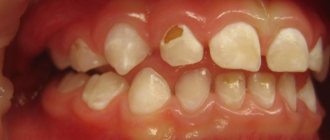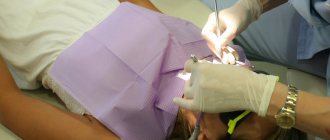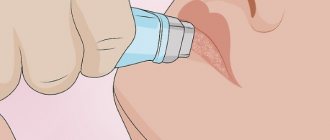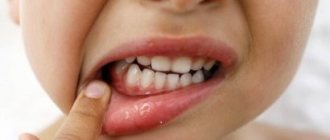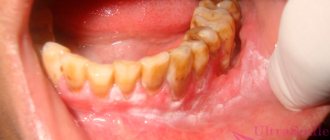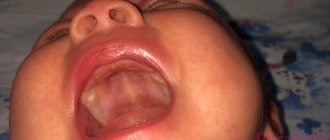Many parents sooner or later wonder why white spots form on their child’s front and chewing teeth. This phenomenon can occur for many reasons, so it is important to consult a doctor as soon as possible to identify them and then prescribe effective treatment.
If the problem is not associated with a pathological process and is just an aesthetic defect, you can cope with it by following the dentist’s recommendations at home. When the situation is advanced, serious dental intervention in the clinic using a drill and filling cavities cannot be avoided.
It is better to prevent pigmentation from occurring, because the problem is much easier to prevent than to treat. Experts have developed a set of recommendations that help prevent the appearance of whitish spots.
White spots on baby teeth in an infant and older child
This is an alarming symptom that requires urgent consultation with a pediatric dentist. Some parents mistakenly believe that there is no need to treat the first teeth, because they will soon fall out and be replaced by permanent ones. This is a misconception that can cost your oral health.
Whitening of areas indicates their demineralization. If urgent measures are not taken, the unit may simply fall out or split into several fragments. As a result, the rudiments of new incisors, canines and molars are damaged. You won't be able to deal with this on your own. For treatment, therapeutic tactics are developed together with an experienced specialist in the field of pediatric dentistry.
White spots on molars
This phenomenon occurs much less frequently than in the case of dairy rows. The process is often observed when installing a bracket system. The problem is provoked by an unbalanced, irregular diet, insufficient consumption of fresh vegetables and fruits, and milk. If this is really the root cause, it is enough to change the diet or reinstall the corrective orthodontic structure.
In adolescence, whitened areas often indicate the onset of caries development. If you contact a dental clinic in a timely manner, you will not need drilling of the affected tissue, filling or cleaning of canals after forced removal of the nerve.
Causes of white spots on a child’s teeth
The problem can arise due to many factors. The most common of them:
- Hypoplasia. This is severe thinning, partial or complete absence of enamel.
- Caries. A natural result of poor quality care and untimely visit to the dentist for preventive purposes.
- Fluorosis. This term refers to an excessive concentration of fluoride in a child’s body.
- Wearing orthodontic appliances. Hygiene is difficult, so carious lesions often occur.
- Injury (including dairy rows).
- Decreased immune defense, frequent colds, viral infections.
- Failure to comply with simple hygiene requirements.
It is worth dwelling on each of the reasons for the occurrence of white spots on teeth in infants and children of an older age category.
Enamel hypoplasia
This is a congenital non-carious pathology of dental units, when a complete or partial absence of the enamel layer is diagnosed. The appearance of incisors, canines and molars changes significantly. Not only whitish areas appear on them, but also grooves and depressions.
The disease is associated with the abnormal structure of hard tissues. It is often accompanied by carious lesions, increased sensitivity to hot and cold foods, sour and sweet foods.
The anomaly originates during the period of intrauterine development or under the influence of external factors. Most often the problem is provoked by:
- Rh conflict between mother and fetus;
- infections suffered by a pregnant woman;
- late gestosis, premature delivery, birth injuries;
- poor nutrition of the expectant mother, taking prohibited medications;
- traumatic effects on the baby’s maxillofacial area;
- endocrine disorders;
- diseases of the gastrointestinal tract, nervous and urinary systems.
Caries
If white spots appear on a child’s teeth, mom and dad most often do not even suspect the presence of carious lesions. The sooner the problem is diagnosed, the faster and easier it will be solved. In the earliest stages, it is often possible to avoid drilling with a drill, which is extremely important when treating small patients. In this case, remineralization or fluoridation is used.
If you do not intervene in time, the enamel will become even thinner, softer and begin to collapse. You can feel the rough surface to the touch.
The spots remain whitish for a short time, they darken. At the same time, infectious agents penetrate into the deepest layers of the crown and root, causing more serious dental diseases that are difficult to treat.
Excess or lack of fluoride
Excessive concentration of the substance in the body is called fluorosis. It reaches a small person through drinking (in some regions the water supply contains excessively fluoridated water), food (seafood), pastes, medicines and polluted industrial air.
Growing teeth are most susceptible to damage, so the problem is more often detected in children. Children with weak immunity and chronic pathologies are especially vulnerable.
Not only excess, but also deficiency of fluoride can provoke a number of dental disorders. Low fluoride content leads to caries and gum disease.
Braces and the consequences of wearing braces
White spots on a child’s permanent (molar) teeth (photos can be found on the Internet) are also observed when orthodontic appliances are installed. This is primarily due to insufficient hygienic care of the oral cavity. In children wearing braces, a layer of plaque accumulates, and the enamel may become lighter.
During the correction period, it is important to take good care of your incisors, canines and molars. It is worth cleaning them at least 2 times a day, morning and evening. You need to give up sweets, confectionery, and sour foods. All this leads to pigmentation.
Injuries
Any mechanical impact threatens damage to the enamel, because this layer is naturally quite thin and fragile, especially in young patients. Whitish spots appear on damaged areas as a response to injury.
In modern dentistry, there are cases where blows and falls in childhood led to the appearance of light pigments in adulthood on permanent units.
Damaged rows not only look unsightly, but can also collapse.
Weakened immunity
Numerous medical studies have shown that children, who are most susceptible to colds and viral infections, suffer from mineral deficiencies and inadequate immune defenses. As a result, white spots (stripes, chalky zones) form on the teeth of a one-year-old child.
Special pastes and traditional therapy, of course, can help in the initial stages. However, first of all, it is recommended to visit a dentist to identify the causes of the symptom and prescribe effective comprehensive treatment.
Abuse of bleaching products and procedures
In patients who abuse such manipulations and regularly use whitening compounds, certain areas of the enamel often become lighter. It does not matter who performs the procedure, a professional dentist at a high price or a loving parent at home.
Such incisors, canines and molars look unaesthetic. For this reason, most doctors note the need for subsequent remineralization. With its help, you can not only make your teeth aesthetically attractive, but also strengthen your enamel.
Poor hygiene
Even the youngest patients know that poor quality care leads to a host of dental problems. Children wearing braces especially suffer from this.
As soon as the baby's first central incisor erupts, you can buy a special finger brush and brush your teeth 2 times a day. However, even if teething is still very far away, you still need to take care of your oral cavity. To do this, you can wipe your gums with a piece of gauze or clean cotton cloth soaked in boiled water or herbal decoction.
How does the procedure for removing black plaque on teeth work?
Reliably and safely getting rid of dark spots on enamel is possible only with a professional dentist. Self-removal of black plaque in children using various folk remedies can lead to damage to the surface of the teeth.
Therefore, you should not self-medicate, but it is better to immediately use the services of specialists. At the Esculapius clinic we will find the root cause of the violation of the natural microflora of the mouth and eliminate the aesthetic defect from the enamel. At the same time, we use only effective methods that guarantee the highest quality results.
To treat Priestley's plaque, the Air Flow device is used, as well as ultrasound. During the procedure, a mixture of water, air and soda crystals is sprayed onto the teeth under pressure. The flow removes various types of deposits not only from the surface of the tooth, but also from the interdental spaces.
For children who do not really like brushing their teeth using the Air Flow method, soft plaque is removed with special brushes and pastes. After professional cleaning, the teeth are polished and become smooth, due to which less plaque settles on the enamel.
This procedure is available in our clinic at a reasonable cost. In addition, it is inexpensive to perform silvering of baby teeth - a preventive measure to strengthen the enamel and protect against caries, as well as other hygiene procedures. With us, your child's smile will be healthy and beautiful.
Is it possible to fix the problem at home?
Therapeutic tactics depend on the causes of the disease. If the problem is unsuitable water, it is enough to replace it with bottled water or install special filters in the house that remove fluoride from the liquid. The same goes for toothpastes and medications. It is important to avoid fluoride-containing foods.
When a child has grown teeth with white spots, you need to introduce foods rich in calcium and vitamins into his diet. For example, you should eat more vegetables, cheese, and drink milk.
Often the provoking factor is insufficient oral hygiene. Parents must teach their son or daughter how to properly perform hygiene procedures. Any available and effective teaching methods will do. Currently, there are many educational cartoons and programs that will help you learn all the intricacies of regular cleaning in a playful way.
Treatment
The process of eliminating a defect depends on the true cause of its manifestation. Therefore, there is no single recipe: the dentist proceeds from the individual characteristics of the patient and the degree of enamel damage. If the reason:
- When caries begins, a conservative approach is popular. Remineralization is necessary: saturation of the enamel with minerals using special ionizers, the use of physiotherapy (for example, exposure to ultrasound in parallel with the application of therapeutic compresses to the teeth). It is possible to apply a special preparation that closes the pores on the enamel and restores its smoothness and hardness. If the condition worsens, therapeutic treatment and installation of a modern filling are required.
- Hypoplasia. Silvering of teeth and also saturation with minerals and fluoridation are practiced. Dietary supplements containing calcium, phosphorus, and zinc are prescribed. If the application was late, then after adulthood, veneers or crowns can be used for camouflage.
- Fluorosis. Removing stains requires the use of special applications; electrophoresis is prescribed. It is necessary to drink only filtered, purified water and do not use fluoride-containing pastes. If part of the tooth is already destroyed, a filling is necessary.
- A consequence of wearing orthodontic structures (usually braces). When light spots are visible, procedures for local remineralization are applied. Toothpastes with fluoride are prescribed.
When white or already black spots on the teeth are a delayed consequence of an injury, then, depending on the nature of the damage, the doctor will prescribe conservative restoration (local remineralization, medication) or a radical intervention with reconstruction, splinting, or prosthetics will be required.
Traditional methods of treatment
Adherents of “grandmother’s” methods should resort to them only in cases where the contrasting white spots on the child’s teeth are purely a cosmetic defect and the doctor gives instructions for treatment at home. For example, you can rinse your mouth with a weak solution of table vinegar (2 teaspoons of the substance per 1 spoon of salt and a glass of clean boiled water). This way you can get rid of plaque and restore the balance of minerals. The only disadvantage of this product is that the baby may swallow it out of curiosity or accidentally, so this method is recommended for older children.
There is also a safer strengthening composition for enamel. We are talking about green tea. It contains flavonoids, as well as gallic and chlorogenic acids. With regular drinking of the drink, pigmentation will completely disappear. In addition, the condition of the mucous membranes in the mouth will significantly improve.
The appearance of spots in children
White spots on a child’s teeth often develop due to hypoplasia or reduced immunity. A weakened body becomes vulnerable, the enamel becomes thinner, and the demineralization process starts quickly. Spots appear on the surface of the teeth - bacteria begin to destroy the tissue structure, these are manifestations of caries in the initial stage.
If a child is undergoing orthodontic treatment, then you should follow the doctor’s recommendations and not ignore in-office cleaning of the structures. Braces make it difficult to physiologically clean the surface of the teeth with saliva; the enamel dries out and its shade changes, becoming brown.
Children in their early teens are three times more likely to develop fluorosis than adults. The reason is clear - during this period there is an active change of teeth, tooth enamel is formed. Therefore, doctors focus the attention of adults: the maximum daily dose of fluoride for children is 3 mg.
Light or yellow spots on the teeth appear when the pH of saliva changes - this is a consequence of poor nutrition (for example, eating a lot of sweets).
Fragility of units and the presence of yellow spots in children and adolescents often indicate a lack of minerals. The reason is a weakened state after illness or poor nutrition. The menu for children and teenagers should include foods containing phosphorus, potassium, calcium, and other minerals. You can use high-quality dietary supplements recommended by your dentist.
How to get rid of white spots on teeth
First of all, it is important to consult a doctor to find out the causes of the unpleasant symptom. The pediatric dentist will determine what caused the whitish formations on the teeth, select effective therapeutic methods, and give recommendations for high-quality hygienic care and prevention.
If a carious lesion is detected at the initial stage, no serious intervention is required. In most cases, it is sufficient to use silvering (on primary occlusion), remineralization or ozonation (in the presence of permanent rows). The baby must be taught proper hygiene.
When caries is deep and painful, you cannot avoid using a drill and installing filling material. When the pathological process is advanced, depulpation and even extraction (removal) are indicated.
If an excess of fluoride is detected in a child’s body, the doctor will advise using a paste that does not contain this component. Remineralization is also indicated.
When tooth surfaces become white due to braces or other orthodontic structures, complex treatment is carried out, which includes:
- elimination of carious cavities;
- disinfection;
- replacement of simulators with new ones;
- regular dental monitoring;
- professional cleaning of food debris and accumulated plaque.
How to get rid of it
You won’t be able to get rid of black plaque on children’s teeth at home on your own. The use of aggressive products or methods can cause serious damage to the enamel. To restore the color of teeth, it is necessary to determine the exact cause of the pathology.
If the blackening of teeth is not associated with dental diseases, then treatment is carried out comprehensively. The dentist performs all manipulations to clean the enamel, and another specialist deals with the main disease.
If the cause is unknown or the disease is chronic, the child’s teeth may periodically darken again. Unlike ordinary yellow or brown plaque, black deposits create a pronounced aesthetic defect, so it cannot be done without the help of a dentist.
Prevention of the problem
To prevent the appearance of white spots on the enamel of teeth in children, you need to follow simple preventive recommendations:
- Take your child to the dentist at least twice a year. If you have a predisposition to caries or a malocclusion has been diagnosed, it is recommended to do this more often, approximately every quarter.
- Monitor the quality of care for dental units and the oral cavity as a whole.
- Watch your diet. Nutrition should be complete, varied, balanced. It is important to include products of both plant and animal origin in the menu.
- It is necessary to reduce the consumption of confectionery products, sweet soda, and baked goods.
- Give your baby multivitamins and mineral complexes after illnesses and during periods of active growth and development (strictly in consultation with the doctor).
- Stick to a diet during pregnancy. It is worth including more dairy products and plant foods in your diet.
- Do not use tetracycline during the gestational process, as this substance has a detrimental effect on the enamel.
- Treat all diseases in a timely manner, preventing them from becoming chronic.
- Carry out oral care after the appearance of the first incisor.
- Preschoolers under 4 years old should not buy pastes with fluoride; monitor the level of the element in tap water.
- Listen to the opinion of specialists and avoid self-treatment.
Content:
- Tooth enamel: general characteristics and properties:
- Possible reasons:
- What to do if your child’s baby teeth are brown.
1.1. Maturation of enamel.
2.1. Plaque. 2.2. Enamel hypoplasia. 2.3. Fluorosis. 2.4. Caries. 2.5. Other reasons.
Regardless of its cause, such a problem is a mandatory indication for comprehensive diagnostics. Moreover, we are talking not only about visiting the dentist, but also about consulting a pediatrician and highly specialized specialists, since brown plaque on children’s baby teeth can be the result of either a banal lack of hygiene or any diseases.
Let's sum it up
White spots on growing children's teeth do not always indicate the presence of a pathological process. Despite the positive statistics, you should not do anything on your own or self-medicate without consulting a doctor. You cannot delay a visit to the dental clinic, because it is much easier to get rid of the problem at the initial stage than in advanced cases associated with deep damage.
Sometimes light spots on the enamel indicate serious systemic pathologies, and a simple examination by a dentist will not be enough. Additional tests and advice from specialists will be needed.
By following preventive rules, you can prevent the appearance of light spots. It is important to teach your child to regularly care for his mouth and periodically show him to the dentist.
Home remedies for white spots
In addition to using professional techniques, the dentist will advise you on how to remove white spots on teeth at home. This is, firstly, a balanced, healthy diet - fewer carbohydrates, especially simple ones, more vegetables, fruits, berries, and dairy products. Secondly, brushing your teeth with remineralizing paste and using remineralizing gels.
Such pastes contain an increased amount of substances that promote tooth remineralization. You should not select these products yourself or use them constantly. The duration of the course of home remineralizing remedies is determined by the dentist.
Remineralizing products are divided into several types:
- fluoride-containing pastes - not suitable for fluorosis, but effective in other cases;
- nanohydroxyapatite is a synthesized substance identical to that which is part of enamel and dentin. It is useful for caries at the white spot stage, closes microcracks and eliminates tooth hypersensitivity;
- amorphous calcium phosphate - forms a thin protective film on the enamel, thereby reducing the negative effects of acids and strengthening tooth tissue. Calcium phosphate gels should be applied after brushing with paste for 1-2 minutes per day.
